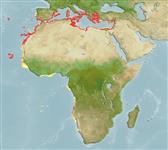| Native range | All suitable habitat | Point map | Year 2100 |

|
| This map was computer-generated and has not yet been reviewed. |
| Diplodus puntazzo AquaMaps Data sources: GBIF OBIS |
Utilisations par l'homme
Pêcheries: commercial; pêche sportive: oui
Phylogenetic diversity index
(Ref. 82805)
PD50 = 0.5000 many relatives (e.g. carps) 0.5 - 2.0 few relatives (e.g. lungfishes)
Niveau trophique
(Ref. 69278)
3.2 ±0.0 se; Based on diet studies.
Résilience
(Ref. 69278)
Milieu, temps minimum de doublement de population : 1,4 à 4,4 années (tm=3)